2009 TOYOTA LAND CRUISER towing
[x] Cancel search: towingPage 3 of 556
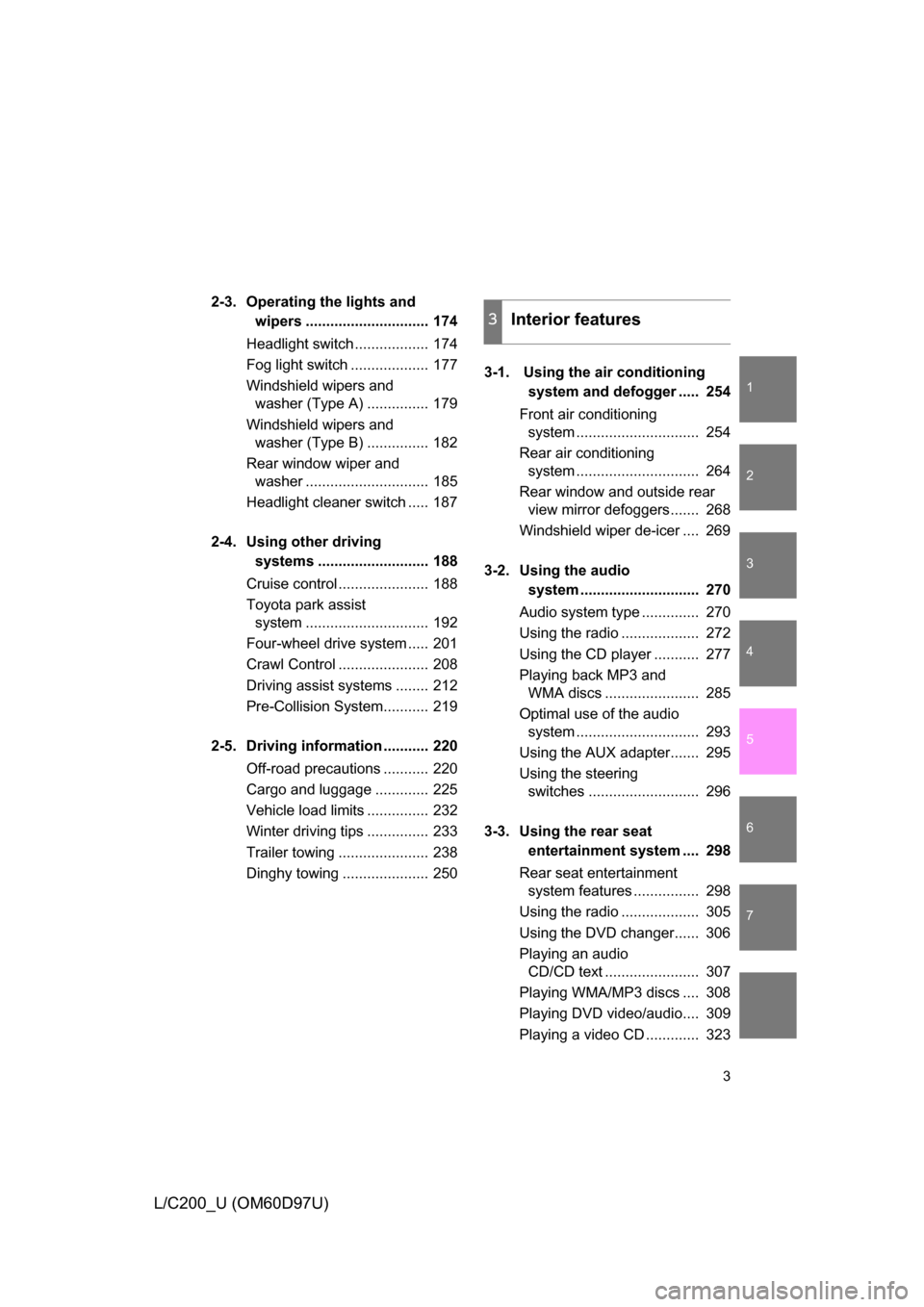
1
2
3
4
5
6
7
3
L/C200_U (OM60D97U)
2-3. Operating the lights and wipers .............................. 174
Headlight switch .................. 174
Fog light switch ................... 177
Windshield wipers and washer (Type A) ............... 179
Windshield wipers and washer (Type B) ............... 182
Rear window wiper and washer .............................. 185
Headlight cleaner switch ..... 187
2-4. Using other driving systems ........................... 188
Cruise control ...................... 188
Toyota park assist system .............................. 192
Four-wheel drive system ..... 201
Crawl Control ...................... 208
Driving assist systems ........ 212
Pre-Collision System........... 219
2-5. Driving information ........... 220 Off-road precautions ........... 220
Cargo and luggage ............. 225
Vehicle load limits ............... 232
Winter driving tips ............... 233
Trailer towing ...................... 238
Dinghy towing ..................... 250 3-1. Using the air conditioning
system and defogger ..... 254
Front air conditioning system .............................. 254
Rear air conditioning system .............................. 264
Rear window and outside rear view mirror defoggers....... 268
Windshield wiper de-icer .... 269
3-2. Using the audio system ............................. 270
Audio system type .............. 270
Using the radio ................... 272
Using the CD player ........... 277
Playing back MP3 and WMA discs ....................... 285
Optimal use of the audio system .............................. 293
Using the AUX adapter....... 295
Using the steering switches ........................... 296
3-3. Using the rear seat entertainment system .... 298
Rear seat entertainment system features ................ 298
Using the radio ................... 305
Using the DVD changer...... 306
Playing an audio CD/CD text ....................... 307
Playing WMA/MP3 discs .... 308
Playing DVD video/audio.... 309
Playing a video CD ............. 323
3Interior features
Page 141 of 556
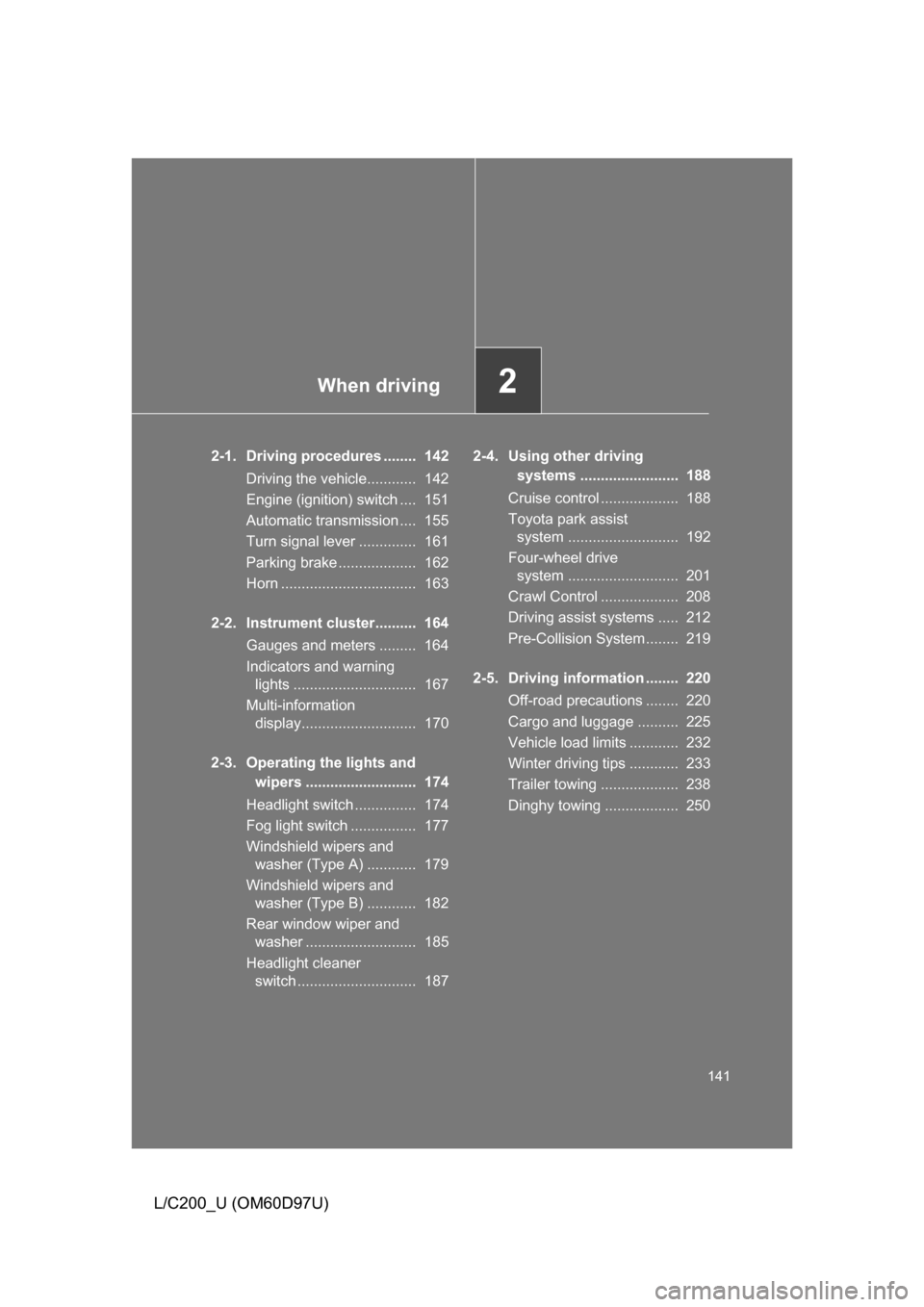
When driving2
141
L/C200_U (OM60D97U)
2-1. Driving procedures ........ 142Driving the vehicle............ 142
Engine (ignition) switch .... 151
Automatic transmission .... 155
Turn signal lever .............. 161
Parking brake ................... 162
Horn ................................. 163
2-2. Instrument cluster.......... 164 Gauges and meters ......... 164
Indicators and warning lights .............................. 167
Multi-information display............................ 170
2-3. Operating the lights and wipers ........................... 174
Headlight switch ............... 174
Fog light switch ................ 177
Windshield wipers and washer (Type A) ............ 179
Windshield wipers and washer (Type B) ............ 182
Rear window wiper and washer ........................... 185
Headlight cleaner switch ............................. 187 2-4. Using other driving
systems ........................ 188
Cruise control ................... 188
Toyota park assist system ........................... 192
Four-wheel drive system ........................... 201
Crawl Control ................... 208
Driving assist systems ..... 212
Pre-Collision System........ 219
2-5. Driving information ........ 220 Off-road precautions ........ 220
Cargo and luggage .......... 225
Vehicle load limits ............ 232
Winter driving tips ............ 233
Trailer towing ................... 238
Dinghy towing .................. 250
Page 199 of 556
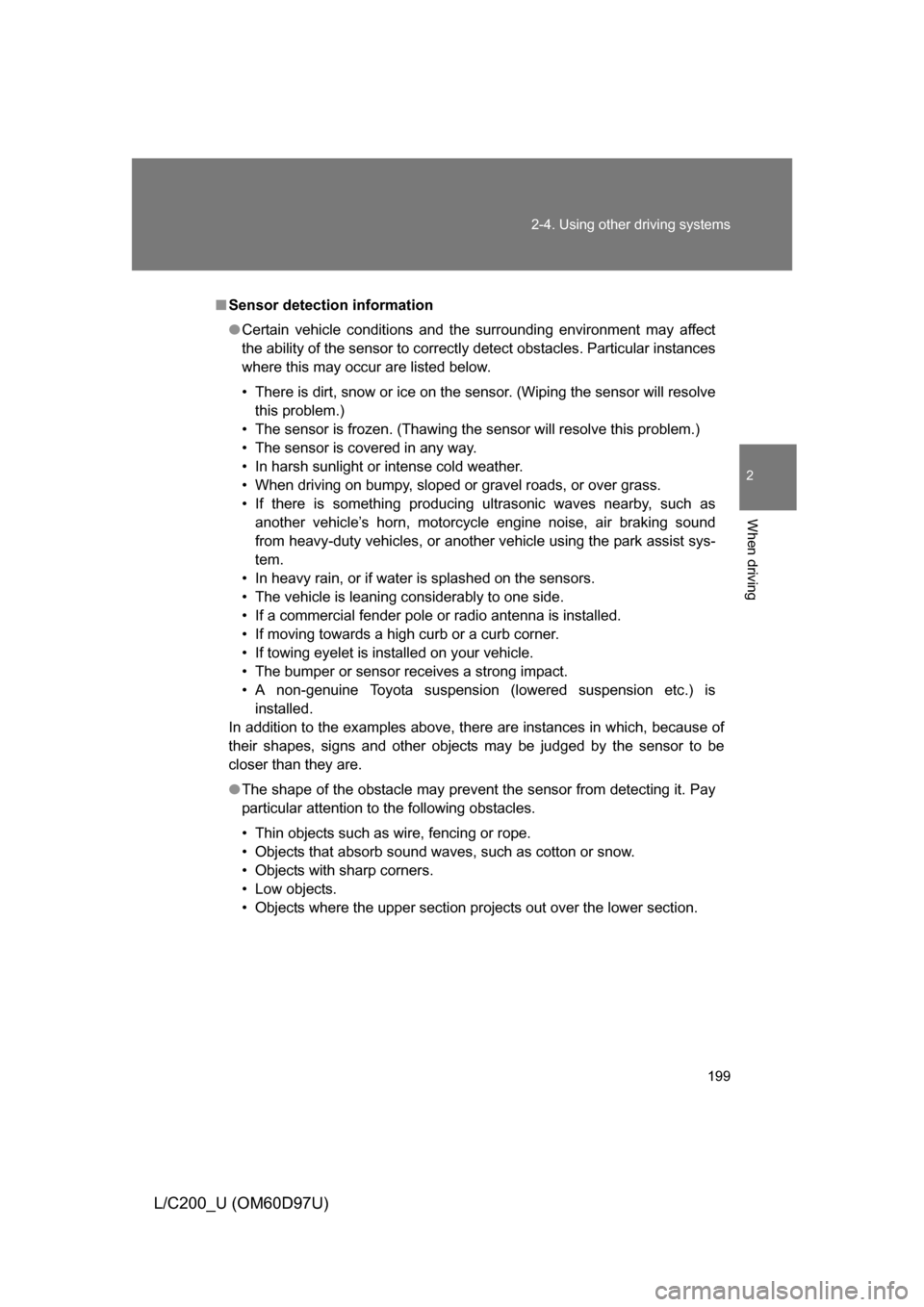
199
2-4. Using other
driving systems
2
When driving
L/C200_U (OM60D97U)
■Sensor detection information
● Certain vehicle conditions and the surrounding environment may affect
the ability of the sensor to correctly detect obstacles. Particular instances
where this may occur are listed below.
• There is dirt, snow or ice on the sensor. (Wiping the sensor will resolve
this problem.)
• The sensor is frozen. (Thawing the sensor will resolve this problem.)
• The sensor is covered in any way.
• In harsh sunlight or intense cold weather.
• When driving on bumpy, sloped or gravel roads, or over grass.
• If there is something producing ultrasonic waves nearby, such as another vehicle’s horn, motorcycle engine noise, air braking sound
from heavy-duty vehicles, or another vehicle using the park assist sys-
tem.
• In heavy rain, or if water is splashed on the sensors.
• The vehicle is leaning considerably to one side.
• If a commercial fender pole or radio antenna is installed.
• If moving towards a high curb or a curb corner.
• If towing eyelet is installed on your vehicle.
• The bumper or sensor receives a strong impact.
• A non-genuine Toyota suspension (lowered suspension etc.) is installed.
In addition to the examples above, there are instances in which, because of
their shapes, signs and other objects may be judged by the sensor to be
closer than they are.
● The shape of the obstacle may prevent the sensor from detecting it. Pay
particular attention to the following obstacles.
• Thin objects such as wire, fencing or rope.
• Objects that absorb sound waves, such as cotton or snow.
• Objects with sharp corners.
• Low objects.
• Objects where the upper section projects out over the lower section.
Page 227 of 556
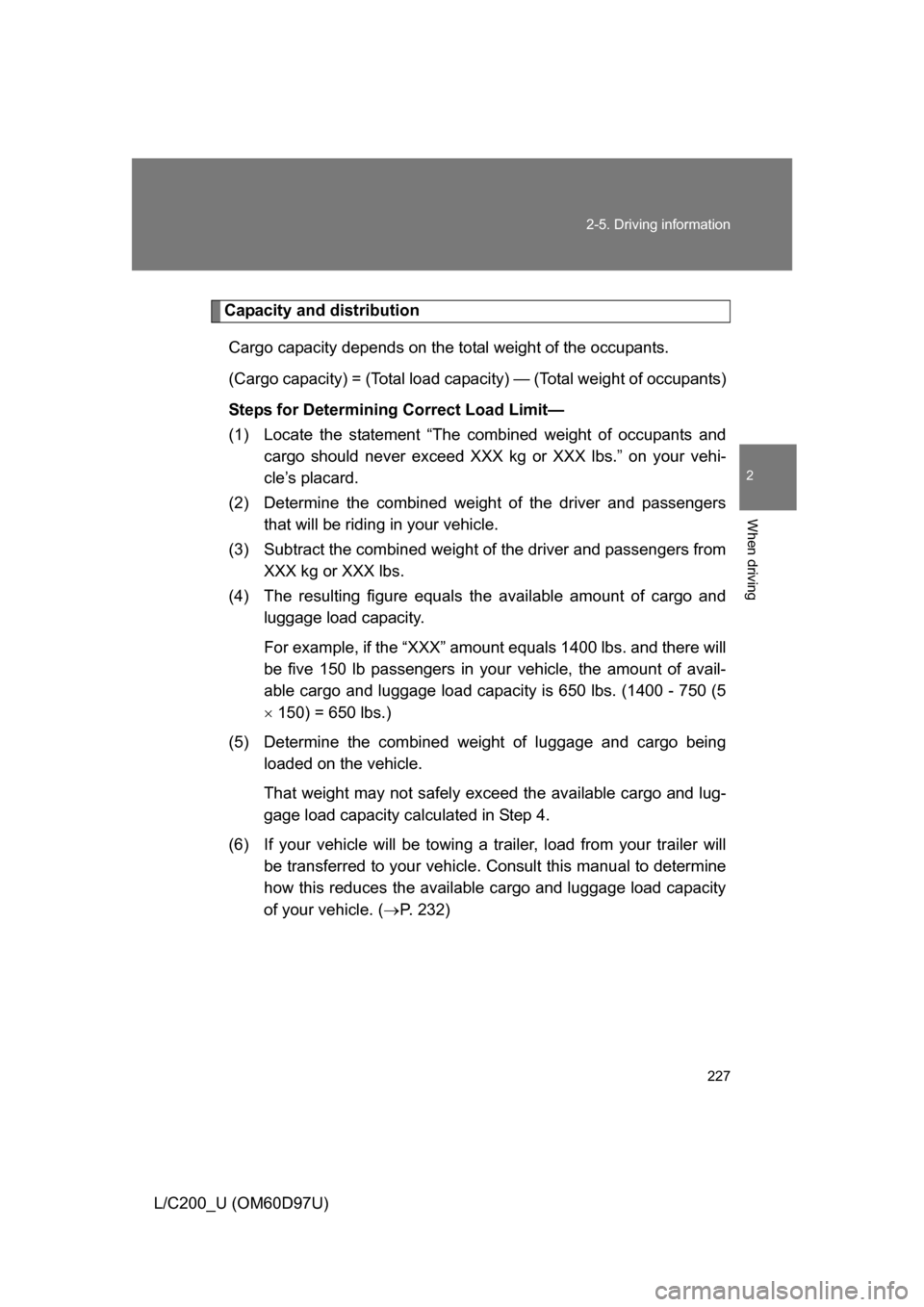
227
2-5. Driving information
2
When driving
L/C200_U (OM60D97U)
Capacity and distribution
Cargo capacity depends on the total weight of the occupants.
(Cargo capacity) = (Total load capa city) — (Total weight of occupants)
Steps for Determining Correct Load Limit—
(1) Locate the statement “The co mbined weight of occupants and
cargo should never exceed XXX kg or XXX lbs.” on your vehi-
cle’s placard.
(2) Determine the combined weight of the driver and passengers that will be riding in your vehicle.
(3) Subtract the combined weight of the driver and passengers from
XXX kg or XXX lbs.
(4) The resulting figure equals the available amount of cargo and luggage load capacity.
For example, if the “XXX” amount equals 1400 lbs. and there will
be five 150 lb passengers in your vehicle, the amount of avail-
able cargo and luggage load capacity is 650 lbs. (1400 - 750 (5
150) = 650 lbs.)
(5) Determine the combined weight of luggage and cargo being loaded on the vehicle.
That weight may not safely ex ceed the available cargo and lug-
gage load capacity calculated in Step 4.
(6) If your vehicle will be towing a tr ailer, load from your trailer will
be transferred to your vehicle. Consult this manual to determine
how this reduces the available cargo and luggage load capacity
of your vehicle. ( P. 232)
Page 232 of 556
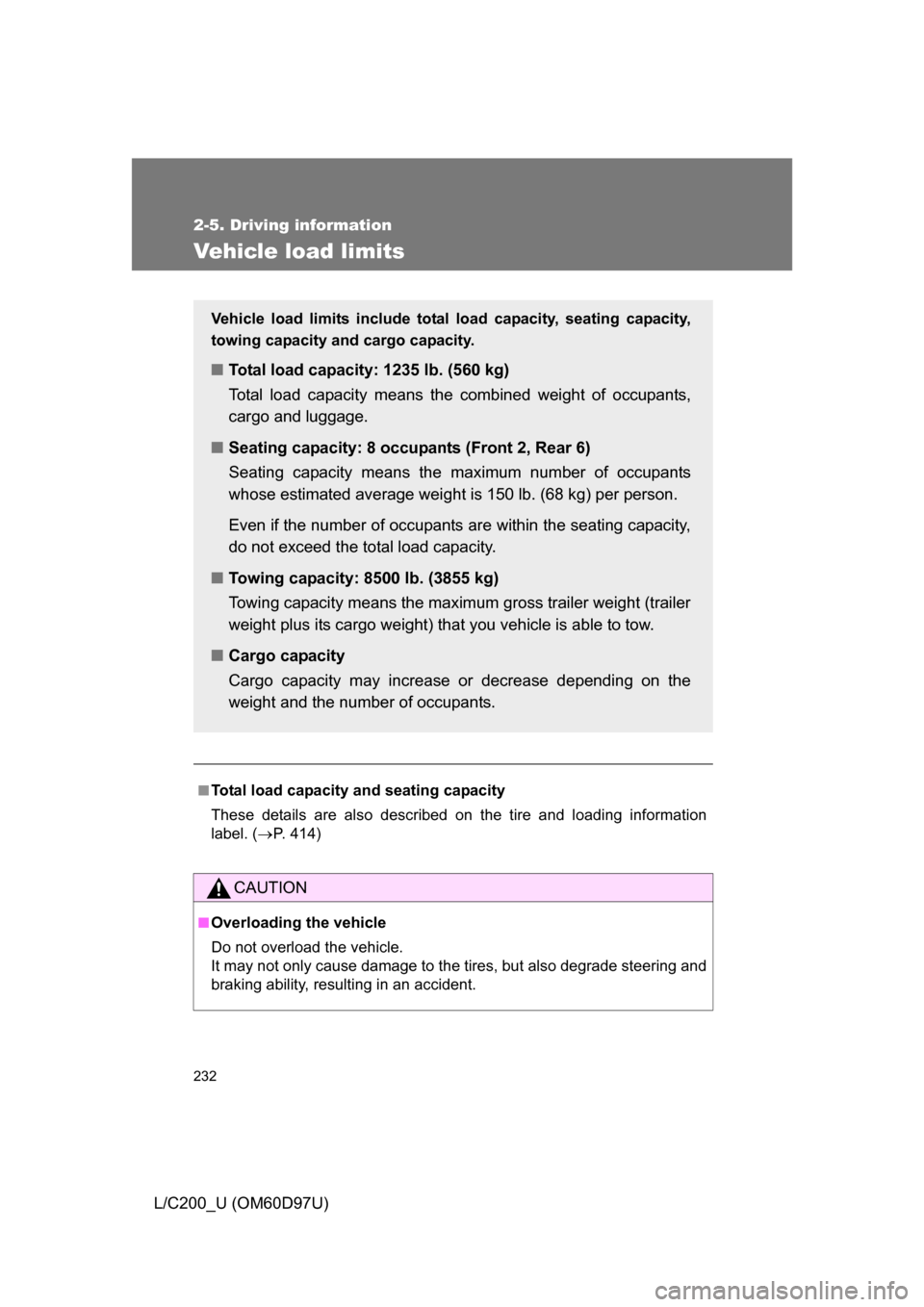
232
2-5. Driving information
L/C200_U (OM60D97U)
Vehicle load limits
■Total load capacity and seating capacity
These details are also described on the tire and loading information
label. (P. 414)
CAUTION
■Overloading the vehicle
Do not overload the vehicle.
It may not only cause damage to the ti res, but also degrade steering and
braking ability, resulting in an accident.
Vehicle load limits include total load capacity, seating capacity,
towing capacity and cargo capacity.
■ Total load capacity: 1235 lb. (560 kg)
Total load capacity means the combined weight of occupants,
cargo and luggage.
■ Seating capacity: 8 occupants (Front 2, Rear 6)
Seating capacity means the ma ximum number of occupants
whose estimated average weight is 150 lb. (68 kg) per person.
Even if the number of occupants are within the seating capacity,
do not exceed the total load capacity.
■ Towing capacity: 8500 lb. (3855 kg)
Towing capacity means the maximum gross trailer weight (trailer
weight plus its cargo weight) that you vehicle is able to tow.
■ Cargo capacity
Cargo capacity may increase or decrease depending on the
weight and the number of occupants.
Page 238 of 556
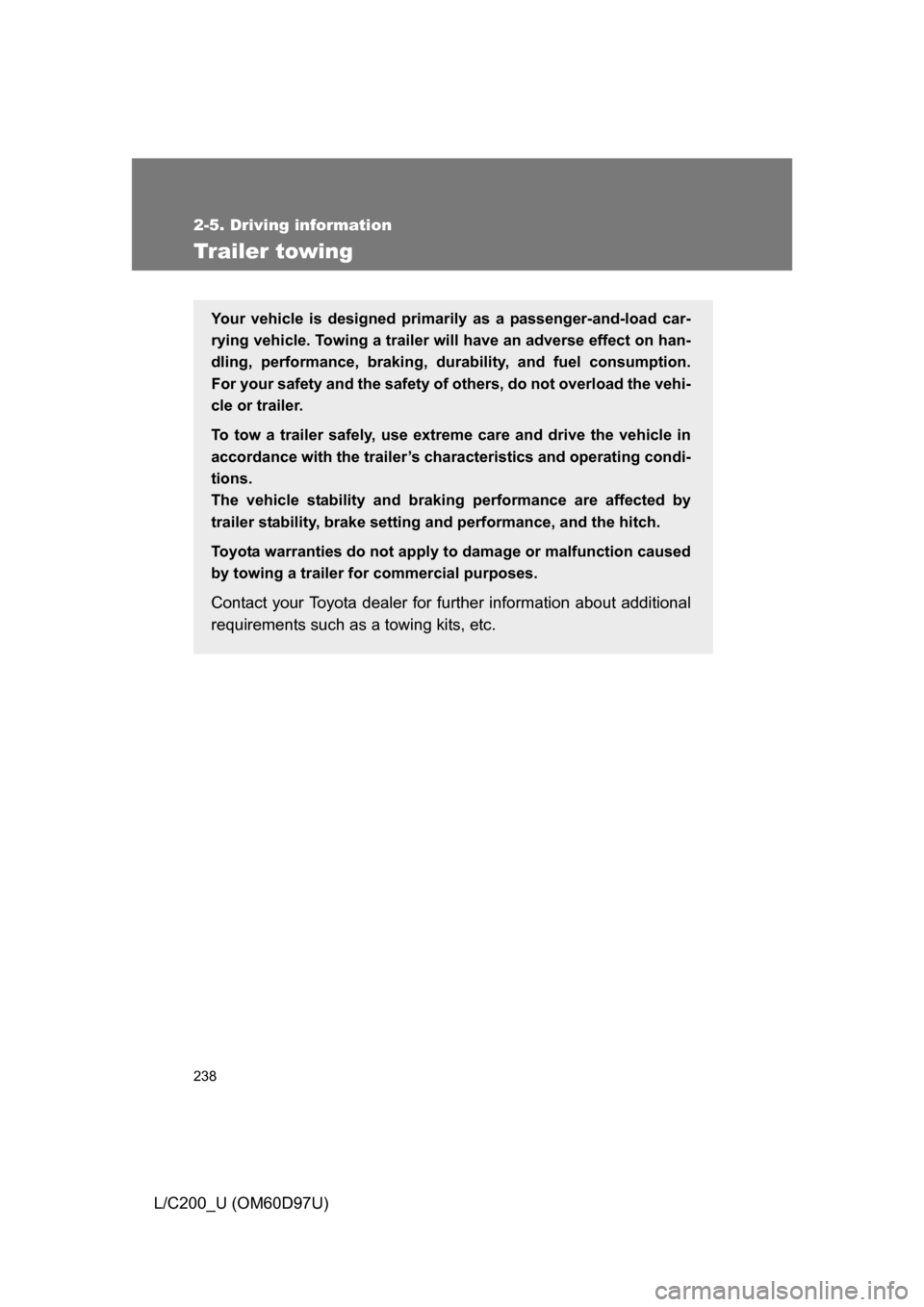
238
2-5. Driving information
L/C200_U (OM60D97U)
Trailer towing
Your vehicle is designed primarily as a passenger-and-load car-
rying vehicle. Towing a trailer will have an adverse effect on han-
dling, performance, braking, durability, and fuel consumption.
For your safety and the safety of others, do not overload the vehi-
cle or trailer.
To tow a trailer safely, use extreme care and drive the vehicle in
accordance with the trailer’s characteristics and operating condi-
tions.
The vehicle stability and braking performance are affected by
trailer stability, brake setting and performance, and the hitch.
Toyota warranties do not apply to damage or malfunction caused
by towing a trailer for commercial purposes.
Contact your Toyota dealer for further information about additional
requirements such as a towing kits, etc.
Page 240 of 556
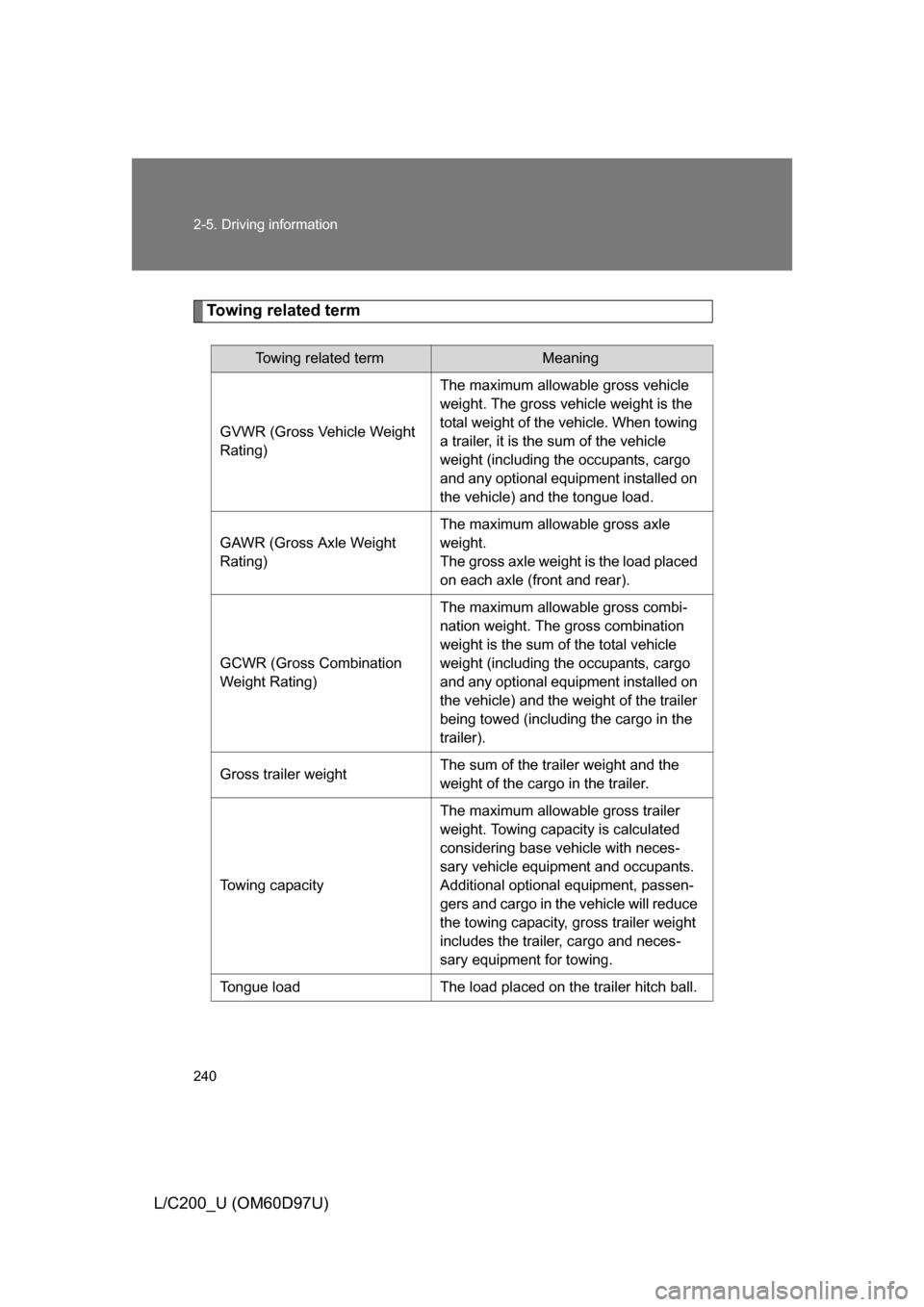
240 2-5. Driving information
L/C200_U (OM60D97U)
Towing related term
Towing related termMeaning
GVWR (Gross Vehicle Weight
Rating) The maximum allowable gross vehicle
weight. The gross vehicle weight is the
total weight of the vehicle. When towing
a trailer, it is the sum of the vehicle
weight (including the occupants, cargo
and any optional equipment installed on
the vehicle) and the tongue load.
GAWR (Gross Axle Weight
Rating) The maximum allowable gross axle
weight.
The gross axle weight is the load placed
on each axle (front and rear).
GCWR (Gross Combination
Weight Rating) The maximum allowable gross combi-
nation weight. The gross combination
weight is the sum of the total vehicle
weight (including the occupants, cargo
and any optional equipment installed on
the vehicle) and the weight of the trailer
being towed (including the cargo in the
trailer).
Gross trailer weight The sum of the trailer weight and the
weight of the cargo in the trailer.
Towing capacity The maximum allowable gross trailer
weight. Towing capacity is calculated
considering base vehicle with neces-
sary vehicle equipment and occupants.
Additional optional equipment, passen-
gers and cargo in the vehicle will reduce
the towing capacity, gross trailer weight
includes the trailer, cargo and neces-
sary equipment for towing.
Tongue load The load placed on the trailer hitch ball.
Page 241 of 556
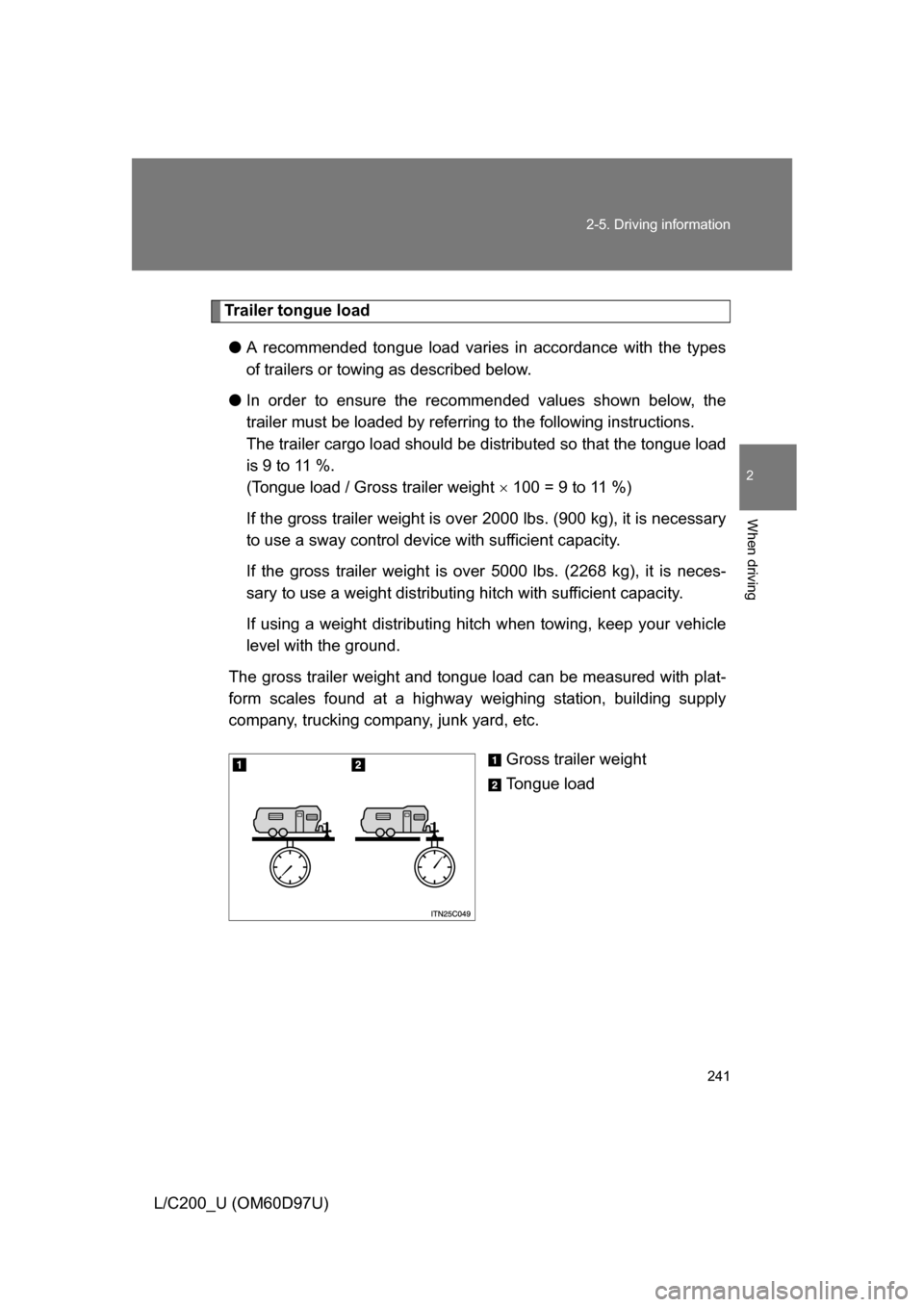
241
2-5. Driving information
2
When driving
L/C200_U (OM60D97U)
Trailer tongue load
● A recommended tongue load varies in accordance with the types
of trailers or towing as described below.
● In order to ensure the recommended values shown below, the
trailer must be loaded by referring to the following instructions.
The trailer cargo load should be di stributed so that the tongue load
is 9 to 11 %.
(Tongue load / Gross trailer weight 100 = 9 to 11 %)
If the gross trailer weight is over 2000 lbs. (900 kg), it is necessary
to use a sway control device with sufficient capacity.
If the gross trailer weight is over 5000 lbs. (2268 kg), it is neces-
sary to use a weight distributing hitch with sufficient capacity.
If using a weight distributing hitch when towing, keep your vehicle
level with the ground.
The gross trailer weight and tongue l oad can be measured with plat-
form scales found at a highway weighing station, building supply
company, trucking company, junk yard, etc.
Gross trailer weight
Tongue load